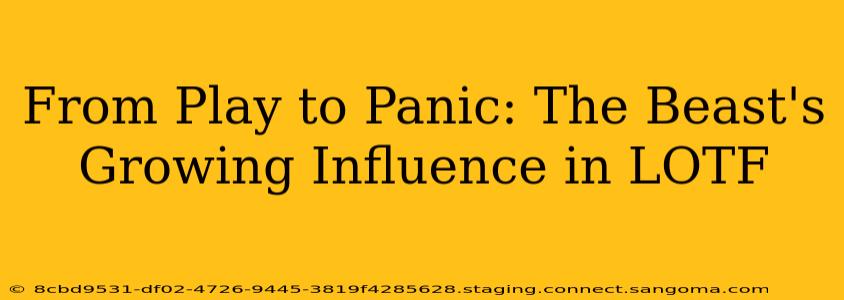William Golding's Lord of the Flies is a chilling exploration of human nature, showcasing how the veneer of civilization can quickly crumble under pressure. Central to this descent into savagery is the enigmatic "Beast," a figure that evolves from a childhood fear into a potent symbol of primal instincts and societal collapse. This essay will delve into the Beast's growing influence throughout the novel, examining its shifting nature and its devastating impact on the boys' fragile society.
What is the Beast in Lord of the Flies?
The Beast initially emerges as a vague, almost childish fear, fueled by Piggy's rational concerns and the boys' superstitions. It's an undefined entity, a product of their collective anxieties and the island's unsettling atmosphere. This early representation of the Beast reflects the boys' anxieties about the unknown and their vulnerability in a hostile environment. It is less a tangible creature and more a manifestation of their inner fears.
Is the Beast Real or Imaginary in Lord of the Flies?
This question forms the crux of much of the novel's tension. Is the Beast a physical entity, a real danger lurking in the shadows of the island? Or is it a purely psychological construct, born from the boys' own deteriorating morals and societal breakdown? The text deliberately avoids a definitive answer, leaving the ambiguity to highlight the blurred line between reality and perception within the deteriorating social order. The "Beast" is arguably both real and imaginary – the boys' fear is real, and its manifestation in their actions and decisions shapes their reality. The appearance of the Lord of the Flies emphasizes the allegorical nature of the Beast – it represents the inherent evil within the boys, not an external threat.
How Does the Beast Evolve Throughout the Novel?
The Beast's significance grows exponentially as the boys descend further into savagery. Initially a whispered fear, it becomes a tangible presence shaping their actions. The fear of the Beast fuels their increasingly violent and ritualistic behaviour. Ralph's attempts to maintain order are constantly undermined by the growing belief in, and fear of, the Beast. The boys' escalating actions, from hunting to the brutal murder of Piggy, serve as a horrific testament to the Beast's insidious influence.
What Does the Beast Symbolize in Lord of the Flies?
The Beast symbolizes several powerful ideas throughout the novel. It represents the inherent evil within human nature – the primal instincts that lie dormant beneath the surface of civilized society. It also symbolizes the power of fear and superstition, illustrating how these forces can erode reason and lead to chaos. Ultimately, the Beast acts as a powerful metaphor for the destructive potential of unchecked power and the loss of innocence. The boys’ descent is fueled not simply by fear of an external threat, but also by their own internal darkness amplified by the circumstances of their isolation.
Does the Beast Represent a Specific Threat?
While the Beast is never definitively identified, it’s suggested the boys' fears are projected onto the island’s environment, particularly the enigmatic "Lord of the Flies." This pig's head, impaled on a stick, becomes a grotesque symbol of their descent into savagery and the embodiment of the Beast itself. The Lord of the Flies, a physical representation, reinforces that the "Beast" isn't an external force, but an internal one: the inherent evil within humanity.
How Does the Beast Affect the Boys' Behavior?
The Beast's influence is devastating, gradually eroding the boys' civilized behavior. Their fear manifests in paranoia, aggression, and ultimately, violence. The hunt for the Beast becomes a distorted parody of civilized pursuits, twisting the boys’ instinct for survival into a bloodthirsty ritual. This transformation highlights Golding's central theme: the fragility of civilization and the ever-present potential for human savagery to overwhelm reason and morality.
Conclusion: The Beast's Enduring Legacy
The Beast in Lord of the Flies is not simply a monster; it is a powerful symbol that resonates deeply with readers. Its evolving nature reflects the gradual disintegration of the boys' society, mirroring the potential for darkness to emerge within even the most seemingly innocent individuals when societal structures crumble. The chilling power of the Beast continues to prompt reflection on the fragility of civilization and the enduring struggle between order and chaos within the human heart.

